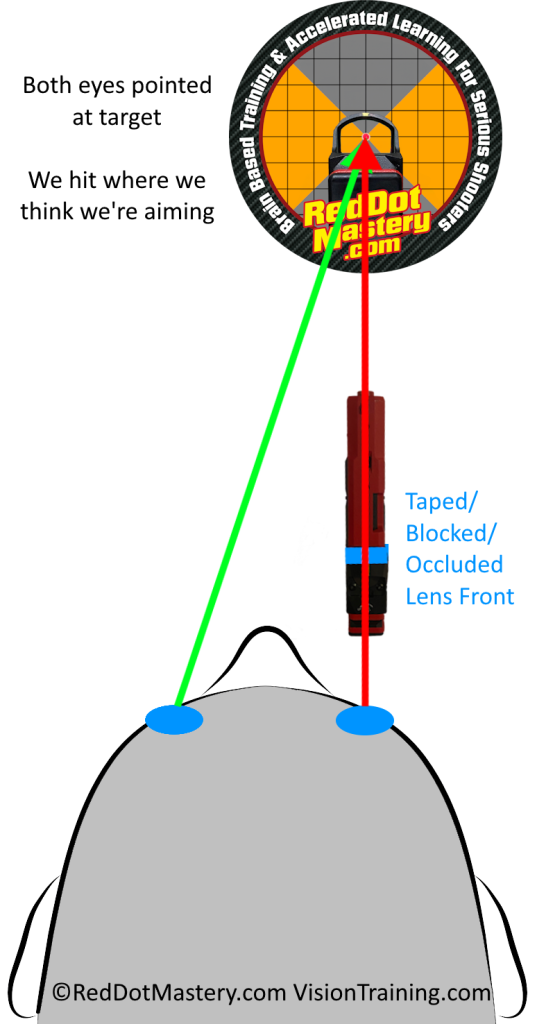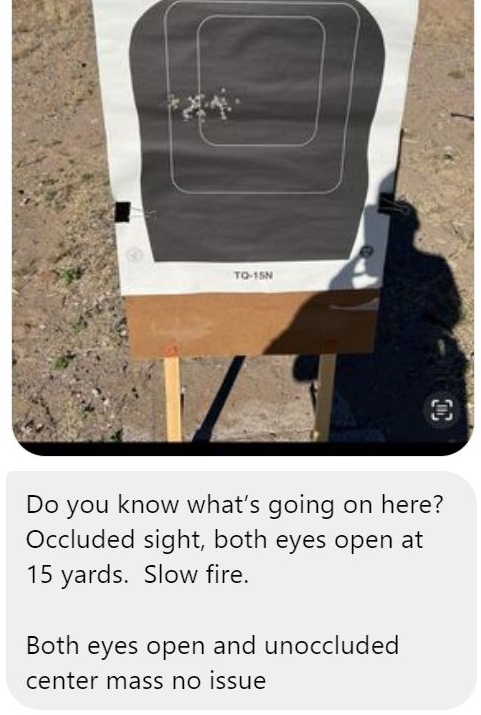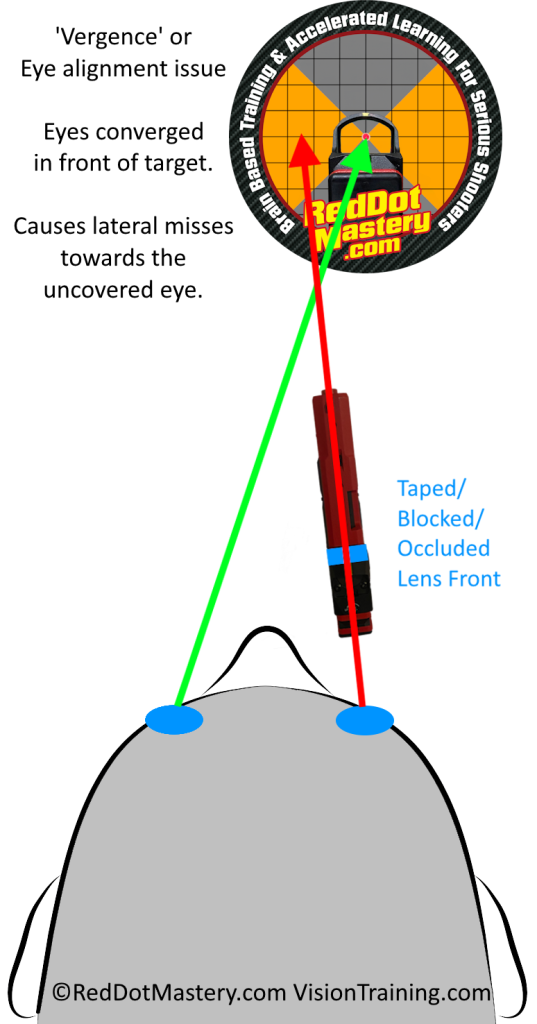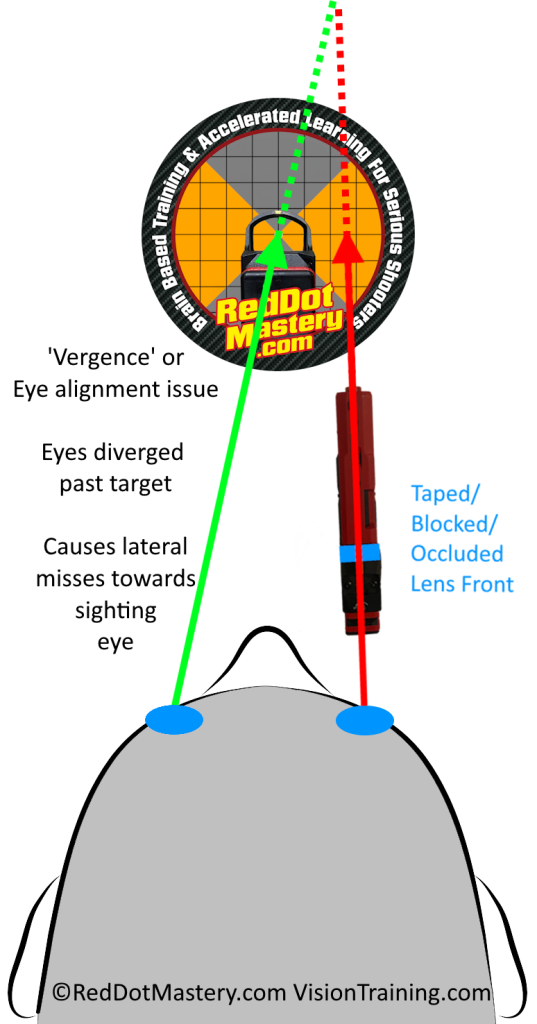A shooter PM’d me a picture of a target (below) where he was doing occluded shooting (tape over the front of his pistol optic) and shot 3 tight slow fire groups at 15 yards…but they were all off to the left. When he didn’t have tape on the lens, he was nailing the bullseye. This is something that I see with both rifle and pistol mounted optics and with people who wear contacts to correct one eye for near vision and the other corrected for far.
The original red dot optics for rifles were basically a tube with an opaque cap on the far end and a red dot in the middle of it that you could see if you looked in the tube.
The idea was that if you looked in the tube at the dot with your dominant eye and look at the target with your non-dominant eye, your brain would combine the images correctly and all you had to do was put the dot on the target and you’d hit it.
It’s called Bindon or Occluded aiming and a lot of people use it (or plan to use it) if the lens of their optic ever gets caked with gunk, if they can’t see through it because of lighting, or other factors that Murphy throws at us.
When the front of the lens is taped, if both of our eyes are pointed at the target, we’ll hit it. When this is the case, Bindon/occluded aiming is awesome.

If our eyes are converged/pointed in front of the target (esophoria), we’ll have a lateral miss towards the eye that we’re not aiming with. When parking a car, we’ll under-estimate distance. When shooting a basketball, we’ll shoot short and have more airballs.
If our eyes are diverged/pointed past the target (exophoria), we’ll have a lateral miss towards the eye that we ARE aiming with. When parking a car, we’ll tend to bump into things more often. When shooting a basketball, we’ll shoot long and have more bricks. When my eyes did this, I tripped more often, stepped on peoples’ feet when I hugged them, and would jam my fingers and smack things when trying to grab them…because I thought everything was further away than it was.
Depending on the study, 10%-80% of people have one of these alignment issues. The huge disparity is because of the makeup of the test subjects. Highly skilled athletes will have fewer alignment issues. Groups of people who get frequent headaches when they read will tend to have more frequent issues with eye alignment.
It is relatively common for the eyes to have correct alignment when both can see the target and for misalignment to happen when one eye can no longer see the target. For people who have eye alignment issues when both eyes are uncovered, it’s common for the issue to get more pronounced when one eye can’t see the target. The alignment issues may be too small for someone else to see. Alignment issues that are too small to show up during an eye exam might still cause issues when shooting.
There are a couple of ways that you can approach this, depending on whether it’s for you or for students and how many people you’re working with and how much time you have.
1. You can do eye circles, pencil pushups, and an Ox String to help get the eyes pointing at the target. I cover these in the See Quicker Shoot Quicker at-home training and you can watch a video demo of the impact that vision drills have on a room of 100 shooters at
https://VisionTraining.com .
2. You can use a different other-than-dot aiming technique instead of Bindon/occluded aiming. We cover several of those in the book,
https://RedDotMastery.com and in the Red Dot Mastery LIVE! Online classes that I’m running throughout the year this year. I’m trying to clear up my schedule to run a Red Dot Mastery LIVE! Class next week…if you’re interested, let me know by replying to the email that got you here or commenting below.
This is another one of those skills where, when you work on it with the goal of shooting better, there’s a good chance that it can positively impact several areas of your life.




1 Comment
Becky Holsopple
February 18, 2024This is making sense to me now. I have a detached retina, which left me with no vision in my left eye. I started gun training to sharpen and broaden my field of vision. I have no depth perception for one and vision to my left is limited. The worst part was my left eye was the dominant one and even after the detachment my brain still tried to keep it as dominant, which led to some scary situations when driving. I am hoping that you have exercises that I can do to fix my one eye shooting. I still keep both eyes open while shooting and dry fire practice. When I shoot it’s still in a pattern in the target just not on it.
Leave A Response